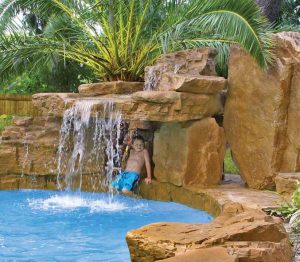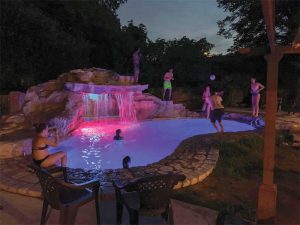Grottos, caves, and cenotes

Most homeowners enquire about grottos and caves after they have seen one on a neighbour’s pool, in a hotel, on a vacation trip, or on the internet. As a result, these features are becoming more prevalent in the residential market.
Creating a visual focal point in the backyard has led many pool professionals to incorporate unique structures into the pool design. One such cave design was inspired by the cenotes of the Yucatan Peninsula in Mexico. Cenotes are large, low-profile freshwater caves sheltered by vast jungles, which essentially integrate into the surrounding landscape. Using a grotto structure and commercial bridge engineering, nearly 6- to 9-m (20- to 30-ft) wide cenotes can be constructed, along with integrated planter boxes that allow foliage to droop and hang over the waterfall, which mimics the look and feel of a jungle encroaching on a pool.
Again, the client may not necessarily ask for a cave or cenote, but these features should be presented because they make the pool appear esthetically pleasing and enhance the entertainment value of the backyard. Caves and grottos are basically a ‘super’ waterfall feature. Not only do they provide all the benefits of a waterfall (visual beauty and the calming sound of cascading water), but also add an element of fun and excitement—especially for children. Pool builders can even incorporate water misters and lighting to heighten the element of mystery for kids. These component systems are, in effect, in the form of a kit, which allow professionals to show clients a brochure of what the final product will look like at the time they sell the job. Builders then order these kits that come with all of the materials necessary to complete the specific project. Each system is constructed by assembling and fitting the component together onto the pool.
Today’s water feature kits are designed to ensure proper water flow, weight distribution, and are structurally stronger than natural rock systems as they are reinforced with steel. Unlike artificial rock systems of the past, which were often cast from rubber moulds, today’s rock component systems look real because they are cast from actual rocks to provide the same shape, character, and texture. Also, cast concrete rocks hold up extremely well to the freeze-thaw temperatures in the northern U.S. and Canada.
Final touches

Adding plants in and around water features is an important final step to ensure the structure integrates naturally into the backyard design. Nowadays, many clients want to build water features around their pool. However, without professional knowledge of pool construction and hydraulics, an unexperienced contractor may unintentionally create a feature that can compromise the pool. Therefore, it is best if pool builders integrate water features into the landscaping along with some help from a local landscape designer. Whether one is creating a visual barrier to block the neighbour’s view or creating a focal point in the backyard, it is critical to choose landscaping that draws the eyes away from areas one wants to cover. For example, strategic use of outdoor lighting can take the attention away from uninviting structures and focus on a new water feature or tree house.
Planting areas should also be planned into or around water features and accessories, such as slides. Incorporating natural elements such as potted plants or pockets of greenery into the mix will help to soften the edges and provide an oasis effect. For example, areas on the side and back of the feature can double as a herb garden for the homeowner.
Pool builders should get creative and allow the project to accomplish multiple goals for the client—from creating privacy to providing tranquil ‘white noise’ from water flowing down the slide, and adding a fun element in the backyard. Choosing individual planting areas, which resemble rock-growing plants often found within a natural waterfall, can even be fed by a built-in irrigation system.
Get creative
Whether it is a tree house, zipline, slide, climbing wall, or cenote that one decides to add to their backyard project, installers must let their creative juices flow and build practical, but inspiring backyard designs around their clients’ pools. At the end of the day, one must aim to exceed their clients’ expectations to ensure future assignments and referrals.
 Zayvian Camacho is a resident of Austin, Texas. While taking classes in landscape design, he started doing product design at RicoRock. Camacho has overseen the development of the new 2.1-m (7-ft) climber—a vertical waterfall unit—built on a structural steel frame; this meshes well with his primary hobby, which is rock climbing. He is also part of the design and fabrication team, developing new waterfalls and working on select construction projects. He can be reached via email at zayvian@ricorock.com.
Zayvian Camacho is a resident of Austin, Texas. While taking classes in landscape design, he started doing product design at RicoRock. Camacho has overseen the development of the new 2.1-m (7-ft) climber—a vertical waterfall unit—built on a structural steel frame; this meshes well with his primary hobby, which is rock climbing. He is also part of the design and fabrication team, developing new waterfalls and working on select construction projects. He can be reached via email at zayvian@ricorock.com.






